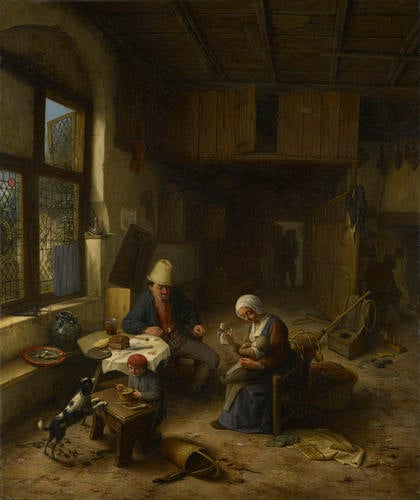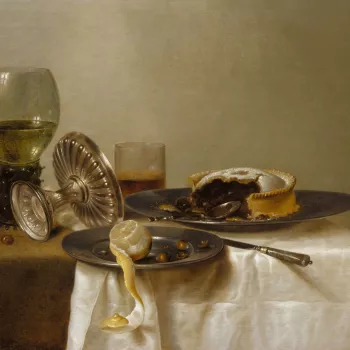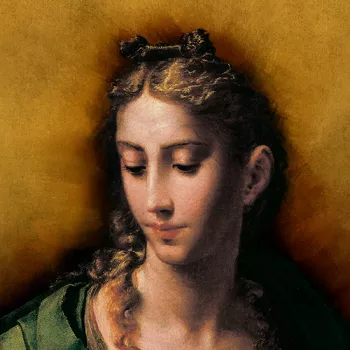The Interior of a Peasant's Cottage Signed and dated 1668
Oil on panel | 49.0 x 41.2 cm (support, canvas/panel/stretcher external) | RCIN 404814
-
The interior of a peasant’s cottage is one of van Ostade’s greatest paintings. It is in complete contrast with those representations of bourgeois figures by artists such as de Hooch or Metsu. Having begun by focusing on the rowdiness and boorishness of peasants, by the 1650s van Ostade had chosen to develop a more sympathetic depiction of peasant life. Here he shows a mother holding up a doll for her child to play with, watched by a doting father. An older child eats from a bowl on a stool, closely observed by a dog. The eye then begins to take in all the other details of family life strewn across the floor - the shopping basket, the laundry basket, the children’s elaborate chamber pot, the broom, various games, the walking frame. The light comes through the latticed windows on the left, as in van Ostade’s earlier picture on a similar theme. At the top an open window suggests that it is summer; it is echoed by the open cupboard door. This is a spacious composition combining a successful application of perspective that leads the eye back into the deeper recesses of the room, tonal nuances that create a sense of atmosphere, and an extraordinary accumulation of realistic detail. The range of objects painted by van Ostade in order to re-create this peasant interior is formidable. The concentration of light on the principal figures is such that only gradually does the viewer realise that there are other figures in the shadowed recesses of the room.
Van Ostade’s composition is reminiscent of The Holy Family by Rembrandt (Louvre, Paris) of 1640 and further knowledge of Rembrandt is displayed in van Ostade’s etching of a peasant family of 1647. As in Rembrandt’s works, it is van Ostade’s powers of empathy that bring great distinction to a painting such as The interior of a peasant’s cottage, and in many respects collectors in the eighteenth century regarded van Ostade’s achievement as comparable with Rembrandt’s. It was his degree of realism that impressed artists and collectors of the nineteenth century, although from that moment his reputation began to decline. The painting was in the Smeth van Alphen collection in Holland in the early nineteenth century and was acquired by George IV in 1811.
Signed and dated over the fireplace on right: Av. Ostade/1668 (Av in monogram)
Catalogue entry adapted from Enchanting the Eye: Dutch paintings of the Golden Age, London, 2004Provenance
P.de Smeth van Alphen, his sale, Amsterdam 1810; bought P.J.Lafontaine, his sale, Christie's, 12 June 1811 (59); but apparently bought privately by Lord Yarmouth for the Prince Regent, ahead of the sale; received at Carlton House 13 June 1811; recorded in the Rose Satin Room at Carlton House in 1819 (no 23); where it appears in Pyne's illustrated Royal Residences of 1819 (RCIN 922181); in the Picture Gallery at Buckingham Palace in 1841 (no 26)
-
Medium and techniques
Oil on panel
Measurements
49.0 x 41.2 cm (support, canvas/panel/stretcher external)
65.1 x 57.2 cm (frame, external)
Category
Object type(s)
Other number(s)













